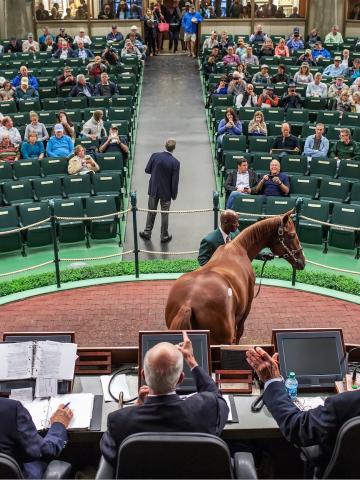
Auctioneer: the man who proclaims with a hammer that he has picked a pocket with his tongue. – Ambrose Bierce, The Devil’s Dictionary
By Steve Zorn
On Monday, Stanford University Professors Paul Milgrom and Robert Wilson won this year’s Nobel Prize in economics for their work on “auction theory.” So, what do these eminent economists have to say about the way that auctions do and should work, and what, if anything, does that have to do with racing? Close to half of any year’s US thoroughbred foal crop is sold at auction, as weanling’s, yearlings or two-year-olds, or, in some cases, in more than one of those categories.
Some horses are raced by their breeders, some are sold privately, but a majority of the horses that end up on the race track got there by way of one or more auction sales. But do the sales work? Do they secure the highest possible return for sellers? Do they avoid, to the maximum extent possible, what the economists call the “winner’s curse” or “buyer’s remorse” for overspending? Do they clear as much of the horse population inventory as possible? This year’s Nobel Prize winners’ work gives us a way to answer those questions.
According to the theory, auction results are affected by three kinds of variables: (1) the auction rules or format; (2) the “value” of the item being auctioned, both the common value perceived by all prospective bidders and the unique, private value that any one buyer might give it; and (3) the amount of shared information available to buyers and the amount of uncertainty that remains. In addition, collusion among bidders and other kinds of backroom deals can affect auction results, as can the reserve prices set by sellers. How do thoroughbred auctions stack up to the theorists’ ideal?
First, as for the auction format. Thoroughbred sales follow the traditional “English” auction model, where bids start low and stop when nobody is willing to top the final bid. The horse goes to the person who made that last bid, at the price she bid, provided it’s above the seller’s reserve. That format has been identified in auction theory as the one most likely, all else being equal, to maximize returns to sellers. So, racing gets an “A” on the rules and format of its auctions. That’s a better format, so they tell us, than a “Dutch” auction, where the auctioneer starts high and stops moving down when someone makes a real bid (think flower auctions in Holland), or a “second-price” auction, where the winning bidder only pays as much as the next-highest bidder offered, plus perhaps a small fixed premium.
But, even here, some tweaks are possible. For example, some of the economists suggest that stopping bidding when there are only two active bidders left and then requiring those two (or perhaps anyone) to submit sealed final bids above the last announced price might yield even more revenue – but at the price of substantially slowing down the process that’s currently able to process 400 horses a day through the ring. And the winning bidder might feel even better if they could be certain that the next-to-last bid was from a real human being, rather than a bid that the auctioneer plucked out of the air to move the price closer to the reserve. The auction teams at Keeneland and OBS have been known to use these imaginary bids, in which case the winning bidder is really bidding against herself.
About the second factor: the perceived value of the item being auctioned: the Nobel winners say, counter-intuitively, that the more information buyers have about the quantity and value of the product, and especially about what similar items have sold for, the higher the purchase price is likely to be. Whether it’s the amount of oil reserves in an offshore lease area, the potential per-capita revenue from a cellular frequency license, or the interest rate on a government bond – all of which, coincidentally are sold in some sort of auction – information increases the price, because shared or common values help convince bidders that they’re not over-valuing the item. It’s fear of that over-valuing that often keeps people from bidding or leads them to drop out as the prices get higher. In horse racing, there’s not a lot of common value. We don’t know which of the 195 Into Mischief foals of 2019, this year’s yearlings, will turn out to be worth $10 million or more as a stallion prospect and which will end up running in $2,500 claimers at Fonner Park. Given that uncertainty, there’s not much about the thoroughbred auction market that can be tweaked to improve results. Grade: B, but that’s just the nature of the business.
As for the third variable, the amount of information that is available to bidders about the nature and quality of the specific item they are bidding for, racing has been steadily improving. Twenty-five years ago, it was up to each individual buyer to collect what information she could on any horse she was interested in, by having her own vet take x-rays or do airway scopes. Then, in 1996, Keeneland opened a voluntary repository where consignors could, if they wished, post x-rays. In recent years, the auction companies have taken more steps to increase the amount of shared data by providing for a required set of x-rays, throat scopes and other information. But lots of buyers, especially of low- and mid-priced horses, still rely on the one-page vet summary in the consignor’s notebook or the consignor’s verbal assurances in the back ring at the sale. And there’s still lots of private, unshared information, like heart scans or skeletal measurements, that only well-heeled buyers can afford. All the economists’ work strongly suggests that, the more this kind of information is shared among potential bidders, the better the prices will be. For Keeneland, Fasig-Tipton and the other thoroughbred sales companies, that’s an invitation to expand their requirements that consignors share data with potential buyers and expand the scope of that data. Grade: B+/A-, with room for improvement.
The economic research indicates other problems that can interfere with sellers’ achieving maximum revenue. Chief among these, from racing’s point of view, is collusion, as when several buyers combine to bid together, or when a buyer or agent may have a hidden interest in a horse that’s being sold. The latter is prohibited by the sales companies’ conditions of sale and, in Kentucky at least, by law, but it’s an open secret that it still happens. And buyer combinations abound. At this year’s yearling sales, groups like the SF Bloodstock-Starlight-Madaket partnership represented by Donato Lanni, or the West Point-Masiello operation, accounted for a high percentage of the more expensive horses, arguably holding prices down below where they would have been had more independent buyers been in on the action.
So far, we’ve been focusing on the auctions’ ability to produce higher revenue for sellers. How about buyers? How do thoroughbred auctions rate at ensuring buyers won’t suffer the “winner’s curse”? The archetypal example of the winner’s curse is a purchase that turns out to be worth a lot less than the winning bidder paid for it. Sadly, that’s almost guaranteed in thoroughbred sales, at least if one looks only at the economics of the sale. Going back to 2006, when Demi O’Byrne, representing the Coolmore juggernaut of Ireland, and John Ferguson, bidding for the absurdly wealthy Sheikh Mohammed of Dubai, pushed the price of The Green Money to $16 million at the Fasig-Tipton two-year-old sale at Calder, sales toppers have rarely if ever paid for themselves on the race track and only very occasionally as stallion or broodmare prospects.That goes for lower priced horses as well. Most race horses don’t earn back on the track even what it costs to keep them in training, much less their original purchase price. But that’s an almost inevitable result of an auction where bidders’ private values will necessarily be spread across a wide range. And, even if a horse loses money in the long run, the buyer may have psychological satisfactions – the satisfaction of owning a racehorse, the thrill of the winner’s circle – that aren’t accounted for very well in the purely financial calculations that economists favor.
One last suggestion from the Nobel Prize winners’ work: make reserve prices as realistic as possible. When they’re too low, buyers can get too much of a bargain. When they’re too high, too many lots go unsold. If you look at the sales results, you’ll see that a number of horses are listed as sold “PS” or post-sale. That means that a horse failed to meet its reserve in the auction ring and then a prospective buyer took a walk to the barn or phoned the consignor and offered something less than the reserve price, whereupon the consignor decided it was better to sell the horse for a little less than to take it home and try their luck on the race track or look for a private sale. Buyers have always done this sort of post-auction haggling, but the recent inclusion of these sales in the published results makes the auction information more complete and thus strengthens the auction from an economic theory point of view.
So, how would the Nobel Prize Professors Wilson and Milgrom rate thoroughbred auctions? Some improvements possible in providing information and suppressing collusion, but overall, at least a solid B+, and maybe even an A-. This is one area where our industry is doing pretty well.



